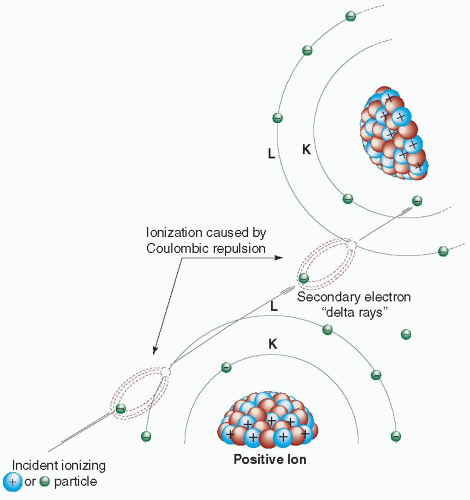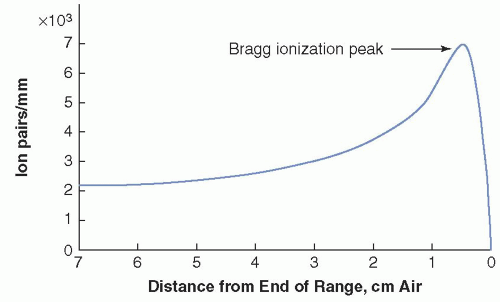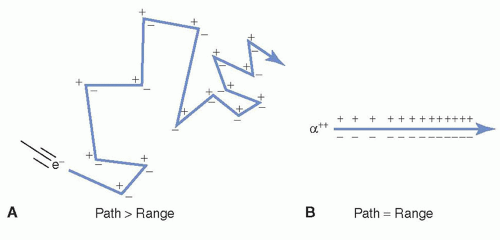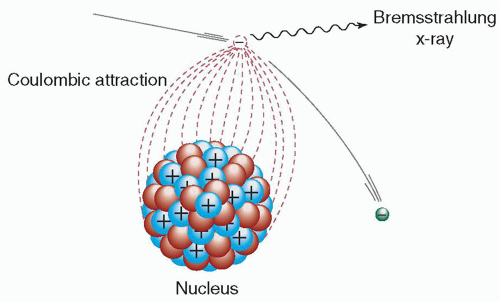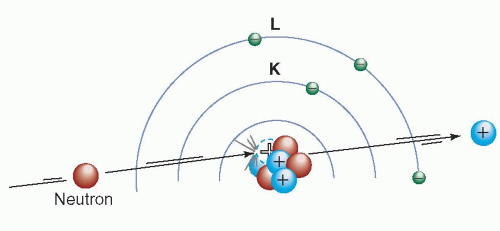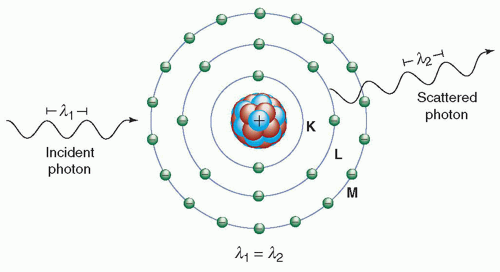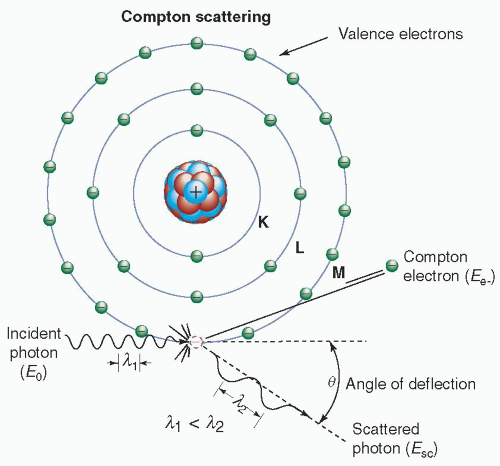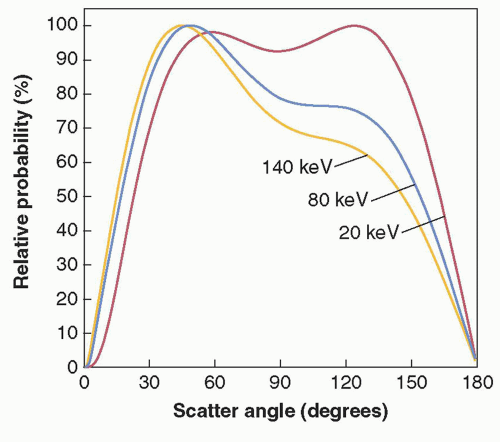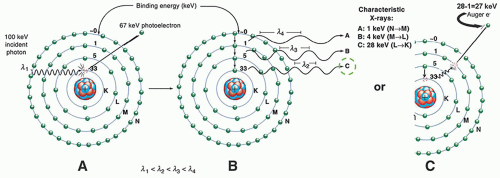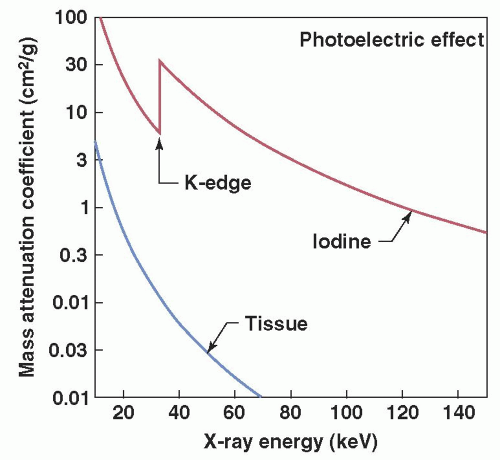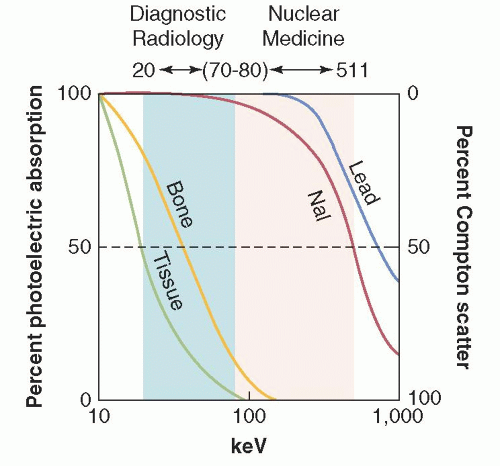Interaction of Radiation with Matter
3.0 INTRODUCTION
This chapter introduces the concepts and principles that govern x- and γ-ray photon interactions with matter and the energetic electrons those interactions set into motion. It considers the fate of these electrons as they subsequently transfer and distribute their kinetic energy in the material they traverse. The photons with energy typical of diagnostic imaging are either completely absorbed by or scattered by electrons in the medium they traverse. Having absorbed this additional energy, the electrons are either elevated to an “excited” energy state within the atom or ejected from it creating a positive ion from a neutral atom. Ejected electrons with sufficient kinetic energy undergo multiple interactions with surrounding electrons during which their energy is transferred to the surrounding medium via excitation, ionization, and radiative emissions.
3.1 PARTICLE INTERACTIONS
Particles of ionizing radiation include charged particles, such as alpha particles (α+2), protons (p+), beta particles (β–), positrons (β+), and energetic extranuclear electrons (e–), and uncharged particles, such as neutrons. The behavior of heavy charged particles (e.g., alpha particles and protons) is different than that of lighter charged particles such as electrons and positrons.
1. Excitation, ionization, and radiative losses: Energetic charged particles interact with matter by electrical (i.e., coulombic) forces and lose kinetic energy via excitation, ionization, and radiative losses. Excitation and ionization occur when charged particles lose energy by interacting with orbital electrons in the medium. These interactional, or collisional, losses occur due to the coulombic forces exerted on charged particles when they pass in proximity to the electric field generated by the atom’s electrons and protons.
2. Excitation:
a. Occurs when energy transferred to an electron does not exceed its binding energy
b. Following excitation (Fig. 3-1A), de-excitation occurs as the electron returns to a lower energy level releasing energy by either:
3. Ionization:
a. Occurs when transferred energy exceeds the binding energy (Fig. 3-2)
b. Electron is ejected from the atom
c. Results in an ion pair consisting of an ejected electron and a positively charged atom
d. Secondary ionization occurs when the ejected electron has sufficient energy to produce further ionization, these electrons are called delta rays
4. Radiative losses:
a. As electron energy decreases, the probability of energy loss via excitation increases
5. Specific ionization:
a. The average number of primary and secondary ion pairs produced per unit length of a charged particle’s path
b. Specific ionization (SI) , where Q is the electrical charge and v is the velocity of the incident particle
, where Q is the electrical charge and v is the velocity of the incident particle
c. The maximum specific ionization is referred to as the Bragg peak
(i) Beyond the peak there is a rapid decrease in SI as the particle acquires electrons, becoming electrically neutral, and losing its capacity for further ionization (Fig. 3-3)
6. Charged particle tracks:
a. Electrons follow tortuous paths as the result of multiple scattering events caused by coulombic deflections (repulsion, and/or attraction), Fig. 3-4A.
b. Heavy charged particles have dense and usually linear ionization tracks (Fig. 3-4B).
c. Path-length of a particle is defined as the distance the particle travels.
d. Range is the depth of penetration of the particle in matter.
7. Linear energy transfer (LET):
a. A measure of the average amount of energy deposited locally in the absorber per unit path length.
b. For charged particles LET ∝ Q2/Ek, where Q is the charge and Ek is the particle kinetic energy
(i) High LET: dense short-range ionization tracks that are much more damaging
(ii) Low LET: sparse ionization patterns and produce less damage to cells
8. Scattering: an interaction that deflects a particle or photon from its original trajectory
a. Elastic collisions: A scattering event in which the total kinetic energy of the colliding particles is unchanged
b. Inelastic collisions: When scattering occurs with a loss of kinetic energy
9. Radiative interactions—bremsstrahlung:
a. Bremsstrahlung describes the radiation emission accompanying electron deceleration (Fig. 3-5).
b. The deceleration of the high-speed electrons in an x-ray tube produces the bremsstrahlung x-rays used in diagnostic imaging.
c. Total bremsstrahlung emission per atom is proportional to Z2 and inversely proportional to the square of the mass of the incident particle, Z2/m2.
10. Positron annihilation:
a. When a positron interacts with an electron, resulting in the annihilation of an electron-positron pair, resulting in the complete conversion of their rest mass into the energy of two oppositely directed 0.511 MeV annihilation photons
11. Neutron interactions:
a. Interaction with atomic nuclei can result in the ejection of charged particles (e.g., protons, Fig. 3-6) or nuclear fission fragments that directly cause excitation and ionization
b. Particles ejected from atomic nuclei and fission fragments created following neutron absorption have very high kinetic energies
3.2 X-RAY AND GAMMA-RAY INTERACTIONS
When traversing matter, photons will penetrate without interaction, scatter, or be absorbed. There are four major types of interactions of x-ray and γ-ray photons with matter: (1) Rayleigh scattering, (2) Compton scattering, (3) photoelectric absorption, and (4) pair production.
1. Rayleigh scattering:
a. Incident photon interacts with/excites the total atom, occurs mainly with very low energy x-rays.
b. The electron cloud immediately emits a photon proportional to that of the change in the photon’s wave energy, but in a slightly different direction (Fig. 3-7).
c. Electrons are not ejected, and ionization does not occur.
d. The average scattering angle decreases as the x-ray energy increases.
2. Compton scattering:
a. Predominant interaction of x-ray and γ-ray photons in the diagnostic energy range with soft tissue.
b. Occurs between photons and valence-shell electrons (Fig. 3-8), the electron is ejected from the atom, and the scattered photon is emitted with some reduction in energy.
c. The ejected electron loses kinetic energy via excitation and ionization.
d. The energy of the incident photon (Eo) is equal to the sum of the energy of the scattered photon (Esc) and the kinetic energy of the ejected electron (Ee-), (Eq. 3-1)

e. The energy of the scattered photon can be calculated using Equation 3-2, where Esc = energy of the scattered photon, Eo = incident photon energy, and θ = angle of the scattered photon

f. As incident photon energy increases, the fraction of energy transferred to the scattered photon decreases and the photon and electrons are preferentially scattered in the forward direction (Fig. 3-9).
3. The photoelectric effect:
a. Occurs when the incident photon energy is greater than or equal to the binding energy of the ejected electron.
b. All of the incident photon energy is transferred to an electron, which is ejected from the atom.
c. The kinetic energy of the ejected photoelectron (Epe) is equal to the incident photon energy (Eo) minus the binding energy of the orbital electron (Eb) (Eq. 3-3) (Fig. 3-10A)

d. Following a photoelectric interaction, the atom is ionized, with an inner-shell electron vacancy. Creating a cascade of vacancies to be filled with electrons from a shell with lower binding energies.
e. The difference in binding energy is released as either characteristic x-rays or Auger electrons (see Chapter 2).
f. The probability of photoelectric absorption ∝ Z3/E3, where Z is the atomic number, and E is the energy of the incident photon.
g. Optimal for x-ray imaging as there are no scattered photons to degrade the image.
(i) Probability is ∝ Z3/E3 which explains why the image contrast decreases when higher x-ray energies are used in the imaging process (see Chapters 4 and 7)
h. For every element, the probability of the photoelectric effect, as a function of photon energy, exhibits sharp discontinuities called absorption edges (see Fig. 3-11).
(i) Amplifies differences in attenuation between tissues with slightly different atomic numbers, improving image contrast
4. Pair production:
a. Only occurs when the energies of x-rays and γ-rays exceed 1.02 MeV.
b. An x-ray or γ-rays interacts with the electric field, the photon’s energy is transformed into an electron-positron pair (Fig. 3-13A).
c. The rest mass energy equivalent of each electron is 0.511 MeV, thus the energy threshold for this reaction is 1.02 MeV.
d. The electron and positron lose their kinetic energy via excitation and ionization. When the positron comes to rest, it interacts with a negatively charged electron, resulting in the formation of two oppositely directed 0.511-MeV annihilation photons (Fig. 3-13B).
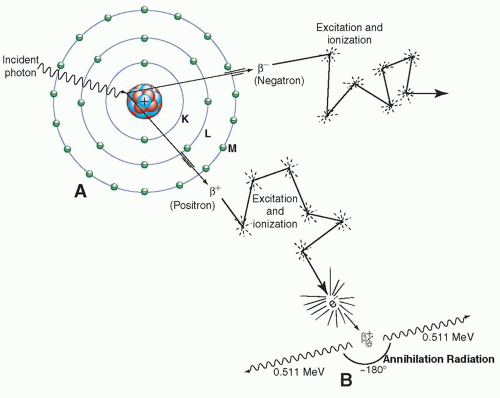 ▪ FIGURE 3-13 A. High-energy incident photon is converted to an electron-positron pair (i.e., energy to mass conversion). B. Positron comes to rest and combines with an electron producing the two 511 keV annihilation radiation photons (i.e., mass to energy conversion).
 F. 3-12 F. 3-12Stay updated, free articles. Join our Telegram channel
Full access? Get Clinical Tree
 Get Clinical Tree app for offline access
Get Clinical Tree app for offline access

|


